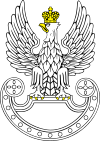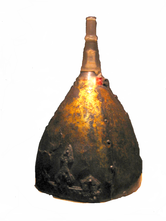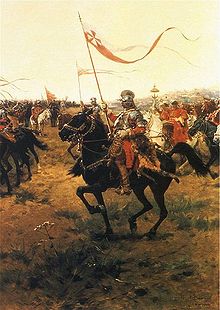- History of the Polish Army
-

Polish
Armed ForcesBranches  Land Forces
Land Forces
 Air Force
Air Force
 Navy
Navy
 Special Forces
Special ForcesHistory Timeline
WarsPersonnel Senior officers
Rank insignia
Awards
OathsEquipment Land Forces
NavyThe Polish Army (Polish: Wojsko Polskie) is the name applied to the military forces of Poland. The name has been in use since the early 19th century, although it can be used to refer to earlier formations as well. Polish Armed Forces consist of the Army (Wojsko Lądowe), Navy (Marynarka) and Air Force (Lotnictwo) branches and are under the command of the Ministry of National Defense (Ministerstwo Obrony Narodowej).
Contents
History
Kingdom of Poland
The first Polish Army was created in the 10th century kingdom of Poland, under the Piast dynasty. The prince's forces were composed of a group of armed men, usually mounted, named drużyna. Their key role was the protection of the monarch and supporting the taxation effort. Their organisation was similar to other such armed units of other Slavic rulers, and were often of foreign origin.
With time, the early tribal warriors gave rise to knights and eventually, by 15th century, the whole social class of the szlachta or Polish gentry. The Polish gentry formed a distinct element within the ancient tribal groupings. This is uncertain, however, as there is little documentation on the early history of Poland, or of the movements of the Slavonic people into what became the territory so designated.
Around 14th century, there was little difference between those called knights and those referred to as szlachta in Poland. Members of the szlachta had the personal obligation to defend the country (pospolite ruszenie), and thereby became the kingdom's privileged social class. It was them who were obliged to build and support castles as well as to keep peace and order on territory they were assigned.
Polish-Lithuanian Commonwealth (First Polish Republic)
Main article: Military of the CommonwealthCommonwealth armies were commanded by four hetmans. The armies comprised:
- Wojsko kwarciane: Regular units with wages paid from taxes (these units were later merged with the wojsko komputowe)
- Wojsko komputowe: Semi-regular units created for times of war (in 1652 these units were merged with the wojsko kwarciane into a new permanent army)
- Pospolite ruszenie: Szlachta levée en masse
- Piechota łanowa, piechota wybraniecka and piechota dymowa: Units based on peasant (later, townsfolk) recruits
- Registered Cossacks: Troops made up of Cossacks, who were recruited until 1699; included many infantry
- Royal guard: A small unit whose primary purpose was to escort the monarch and members of his family
- Mercenaries: As with most other armies, hired to supplement regular units
- Private armies: Usually paid for and equipped by magnates or cities
Some units of the Commonwealth used fairly unique tactics. These units included:
- Husaria: heavy cavalry armed with lances; their charges were extremely effective until advances in firearms in the late 17th century substantially increased infantry firepower.
- Cossacks: general name for all Commonwealth units of light cavalry, even if they did not contain a single ethnic Cossack; fast and maneuverable like oriental cavalry units of Ottoman Empire vassals, but lacking the firepower of European cavalry such as the Swedish rajtars.
- Tabor: military horse-drawn wagons, usually carrying army supplies. Their use for defensive formations was perfected by the Cossacks, and to a smaller extent by other Commonwealth units.
Army without country
After partitions of Poland, during the period from 1795 until 1918, Polish military was recreated several times in Poland during uprisings like the November Uprising of 1830 and the January Uprising in 1863, and outside Poland like during Napoleon Bonaparte wars (Polish Legions in Italy). The Kingdom of Poland, ruled by the Russian Tsar with a certain degree of autonomy, had a separate Polish army in the years 1815-1830 which was disbanded after the unsuccessful insurrection.
Large numbers of Poles also served in the armies of the partitioning powers, Russia, Austria-Hungary (before 1867 Austria) and Germany (before 1871 Prussia). However, these powers took care to spread Polish soldiers all over their armies and as a rule did not form predominantly Polish units.
During World War I, the Polish Legions were set up in Galicia, the southern part of Poland under Austrian occupation. They were both disbanded after the Central Powers failed to provide guarantees of Polish independence after the war. General Józef Haller, the commander of the Second Brigade of the Polish Legion, switched sides in late 1917, and via Murmansk took part of his troops to France, where he created the Blue Army. It was joined by several thousand Polish volunteers from the United States. It fought valiantly on the French front in 1917 and 1918.
Second Polish Republic
When Poland regained independence in 1918, it recreated its military which participated in the Polish-Soviet War of 1919-1922 and in the Second World War 1939-1945. During the German occupation of Poland, a number of resistance movements were created, of which the Armia Krajowa (Home Army) was perhaps most significant. Main articles: Polish contribution to World War II, List of Polish armies in WWII
People's Republic of Poland
The Polish armed forces, then known as Polish People's Army, were part of the Soviet-controlled Warsaw Pact. Polish units took part in occupying Czechoslovakia in response to the Prague Spring in 1968. The command post for the invasion was actually located on Polish soil, at Marshal Ivan Yakubovsky's Legnica headquarters.[1]
Third Polish Republic
After January 1990 the name of the armed forces was changed to 'Armed Forces of the Republic of Poland,' to accord with the Polish State's new official name.
In March 2003 the Polish Armed Forces took part in the 2003 invasion of Iraq, deploying 1500 personnel, special forces and a support ship (see pl:PKW Zatoka Perska (2003)).[2]
Following the destruction of Saddam's regime the Polish Land Forces supplied a brigade and a division headquarters for the 17-nation Multinational Division Central-South, part of the U.S.-led Multi-National Force Iraq. At its peak Poland had 2,500 soldiers in the south of the country. Poland deployed about ten attack and transport helicopters as part of its force in Iraq between 2004 and 2008.[3]
The troop number was reduced to 900 in 2006. Of the 900 soldiers, only 80 ever left their Forward operating base to conduct operations.
References
- ^ Andrew A. Michta, 'Red Eagle: the army in Polish politics 1944-1988,' Hoover Press, 1990, p.62. Michta's footnote cites 'Testimony of Col. Ryszard Kuklinski, who participated in the preparation of the invasion plans. See Kuklinski p.10'
- ^ Around 200 Polish soldiers took part in combat, including GROM (Mobile-Operational Reaction Group) and FORMOZA (Naval Frogmen Group) special forces, a chemical decontamination unit as well as the ORP Kontradmirał X. Czernicki logistical ship. (Rafał Domisiewicz, Consolidating the Security Sector in Post-Conflict States: Polish Lessons from Iraq, Austrian Ministry of Foreign Affairs)
- ^ 6 PZL W-3 Sokół Helicopters (2003–2006) and four W-3 helicopters 2007-08 (http://gdziewojsko.wordpress.com/listy/w-3-sokol). 6 Mil Mi-24 attack helicopters (2004–2008) (http://www.wojsko-polskie.pl/articles/view/2087/141/smiglowce-mi-24-rozpoczely-wykonywanie-zadan-w-iraku.html). 4 Mil Mi-8 helicopters (2003–2008)(http://www.altair.com.pl/files/sp1203_smig.htm and http://www.altair.com.pl/konfsmig.htm).
See also
- Mount Ormel
- People's Republic of Poland (Polska Rzeczpospolita Ludowa or PRL) - 1944/52 (unofficial), 1952/89 (official)
- Battle of Bautzen (1945)
- Battle of Kolberg (1945)
- Battle of Lenino
- Battle of Warsaw (1920)
- History of Polish Intelligence Services
- Polish First Army
- Polish Second Army
External links
- Official Website of the Polish Army
- Polish Army of the Napoleonic Wars
- Polish Infantry, Cavalry and Artillery during the Napoleonic Wars - uniforms, organization, weapons
Military history of Europe Sovereign
states- Albania
- Andorra
- Armenia
- Austria
- Azerbaijan
- Belarus
- Belgium
- Bosnia and Herzegovina
- Bulgaria
- Croatia
- Cyprus
- Czech Republic
- Denmark
- Estonia
- Finland
- France
- Georgia
- Germany
- Greece
- Hungary
- Iceland
- Ireland
- Italy
- Kazakhstan
- Latvia
- Liechtenstein
- Lithuania
- Luxembourg
- Macedonia
- Malta
- Moldova
- Monaco
- Montenegro
- Netherlands
- Norway
- Poland
- Portugal
- Romania
- Russia
- San Marino
- Serbia
- Slovakia
- Slovenia
- Spain
- Sweden
- Switzerland
- Turkey
- Ukraine
- United Kingdom
States with limited
recognition- Abkhazia
- Kosovo
- Nagorno-Karabakh
- Northern Cyprus
- South Ossetia
- Transnistria
Other entities Categories:- Military history of Poland
- Army history
Wikimedia Foundation. 2010.


